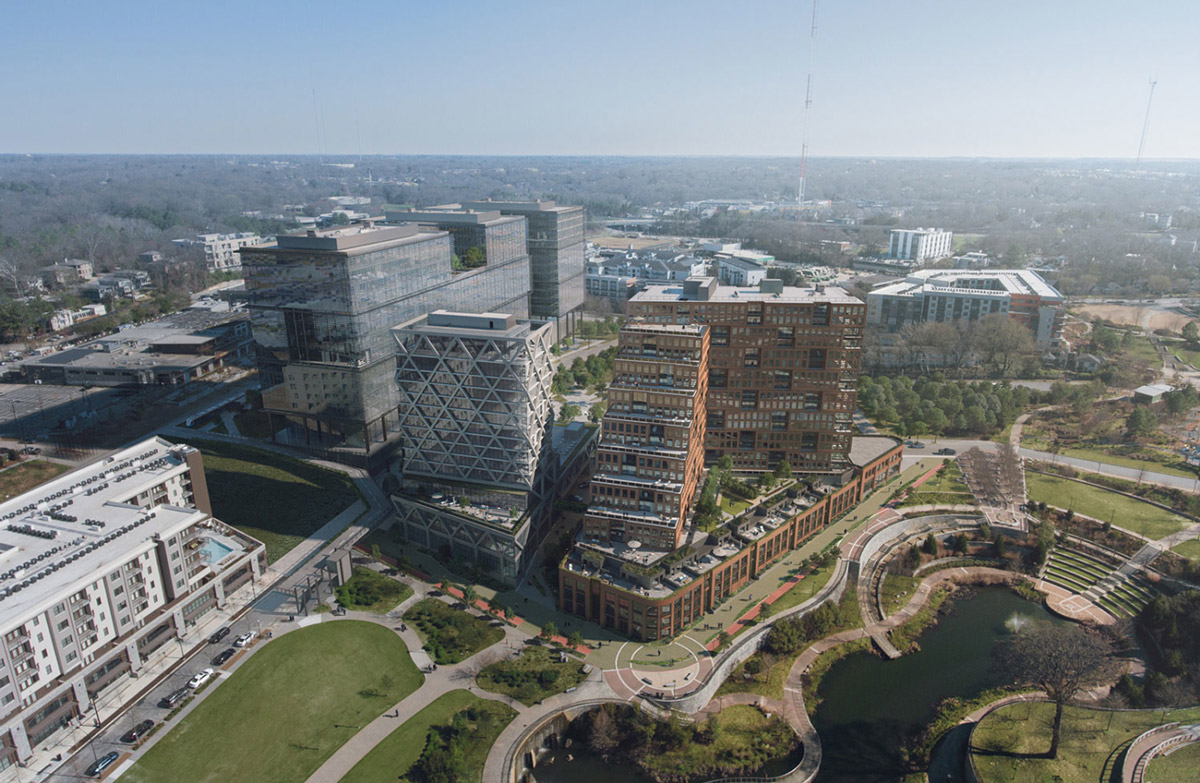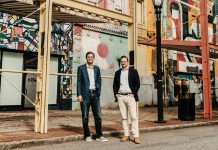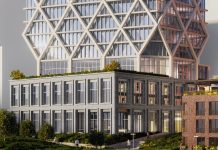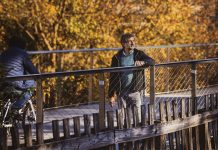
Rendering courtesy of New City
A few weeks ago, patrons of the Atlanta BeltLine’s Eastside Trail probably noticed the addition of tall plywood fencing around a marquee development site, just south of Ponce City Market, where Georgia Power had stored vehicles and materials for half a century. It was tangible evidence that plans for the largest ground-up new development on the BeltLine to date—a 12-acre, mixed-use mini-city expected to eventually cost upwards of $1 billion—hadn’t been scuttled by the COVID-19 pandemic. The site’s owner and developer, New City Properties president Jim Irwin, had planned to commission artists to paint the plywood fencing, but instead, activists against racial injustice turned the fence into a Black Lives Matter mural, with tributes to George Floyd, Breonna Taylor, and Rayshard Brooks, among many others. Irwin was on a bike ride when he saw the graffitists at work.
“It’s amazing,” says Irwin. “What happened was this beautiful, organic moment where the public used [the fence] for something that’s just absolutely, critically necessary.”
View this post on Instagram
As with Irwin, the grassroots BLM artwork raised eyebrows—and triggered conversation—at the Historic District Development Corporation, which is headquartered in South Atlanta, just a couple of blocks from the Wendy’s where Brooks was fatally shot by Atlanta police. (During subsequent protests, 22 windows were broken at the community development group’s building, then boarded up and painted with murals of Black women wearing protective masks.) HDDC board member Donell Woodson said his group initially wondered if the graffiti mural in Old Fourth Ward was being used as a safeguard for the development—akin to a BLM sign staked in a home’s front yard to shield it from potential protest damage. That thought has since triggered an idea, Woodson says: That blurring the lines between for-profit development and the momentum toward equality in urban epicenters right now could spur some good.
“It’s a grand project, in the scope of things, and I want to be cautiously optimistic, but [developers] probably aren’t considering the entire demographic makeup of Old Fourth Ward as their clients,” says Woodson, who’s also the Lupton Center’s lead trainer in community development. “When developments are happening, and they put any signage around it, it’s always about partnership. When you allow BLM for this time period to be put on your fence line, you’re saying something.”
Inside the fence, the site’s activity reflects the nature of development in Atlanta during a global pandemic. Unlike some cities that essentially padlocked construction sites as the novel coronavirus swept the country, Atlanta never paused its growth. But some large-scale development companies have had to pivot, adjust, or reel in expectations for construction timelines they made months ago, amidst the city’s previously roaring economy.
Since New City bought the Old Fourth Ward property for $34 million in 2017, the huge project with no name (more on that later) has been among the city’s most closely watched (and, on occasion, criticized) BeltLine-adjacent ventures, claiming the largest available piece of land left on the popular trail. Demolition and early infrastructure work recently launched, but Irwin balks at saying the project is technically moving forward right now. However, his company’s ambitions for the planned hub of offices, hotel and retail space, and housing (including an affordable housing component) have not changed.
A Buckhead native, Irwin helped lead construction of Ponce City Market before founding New City, where his first major project was the redevelopment of so-called “Murder Kroger” into the 725 Ponce office tower next door. In a wide-ranging phone interview, Irwin discussed that development and the newer venture that would dwarf it, more immediate changes to BeltLine accessibility, and why he’s confident Atlanta will emerge strong from the pandemic’s ongoing malaise.
On next steps for 725 Ponce
With a reimagined, booze-dishing Kroger at its base, the $200-million 725 Ponce building has fully leased all office space across its 12 stories, Irwin says. Tenants include global asset management firm BlackRock and coworking company WeWork, each in various states of building out offices and moving into the building. A large restaurant space atop Kroger, meanwhile, could soon function as a pop-up gallery for the time being.
“We’ve talked to several different operators, who potentially would do sort of short-term retail,” says Irwin. “It’s such an incredible, cool space that’s right there on the BeltLine, with terraced indoor-outdoor space, that instead of feeling urgency to lease it quickly, we feel a lot of pressure to get it perfect. We’ve been in conversations with a handful of ideal operators—James-Beard caliber [restaurants]. Obviously COVID hasn’t done anyone a favor, but it’s hit the [food and beverage] industry pretty hard. Instead of trying to force anything, we’re just being patient.”
A potential second phase of the 725 Ponce project—another large building between Kroger and Green’s package store that would consume surface parking lot space—has been designed but won’t move forward for a while, allowing New City to study traffic patterns and focus on the larger Old Fourth Ward endeavor, Irwin says.

Rendering courtesy of New City
A glassy BeltLine elevator?
Aside from the plywood walls, the most immediate changes BeltLine dwellers will notice is that access to the snaking Gateway trail that leads to Historic Fourth Ward Park is cut off.
The existing connector trail consumes too much land to jibe with New City’s plans. So, as a replacement, the developer agreed in talks with BeltLine officials to close it but immediately begin construction on a glass elevator with a stairway that includes bike runnels, meant to echo the look of elevators along New York City’s High Line. (The park will remain accessible at points just south of the existing Gateway and at North Avenue.) Irwin expects the elevator and stairs to be finished in eight or nine months.
Preliminary work
Georgia Power fully vacated the site in early 2019, and the utility’s 1980s-era brick office building on site has been demolished. Preparing the site for vertical construction will take almost a year in itself, Irwin says, and he fully expects development to be a 10-year effort before its considered finished.
The project caught flak last year when news emerged it could qualify for $22.5 million in public Invest Atlanta funding—in the center of a booming development zone. Irwin says talks involving that funding as an economic development tool are on the backburner and could resume later.
The breakdown
Pandemic be damned, the mix of planned uses—a whopping 1 million square feet of office space in glassy buildings, 200,000 square feet of retail, a 75-key boutique hotel, and roughly 1,100 residences—hasn’t been modified since last year. At least 10 percent of residential units will be reserved as affordable housing for anyone earning 60 percent of the area’s median income, Irwin says.
There’s no solid ETA for when vertical construction might start, but the BeltLine-facing office component will rise first, with an expected construction timeframe of about two years.
New City has elected to not name the project. Why not?
“What we’re purposefully trying to do is just weave elegant additions into the already beautiful fabric of the Old Fourth Ward,” says Irwin. “To name it one thing would be sort of antithetical to what we’re trying to do. We just call it the Fourth Ward project.”

Rendering courtesy of New City
Pandemic’s impact on mixed-use design
“What COVID will do in the long term, I believe—and I’m not trying to be a soothsayer—but one of the implications is that it has renewed the public’s focus on health and wellness, and living and working in environments where that is promoted,” says Irwin. “And what better location in the City of Atlanta than the BeltLine? We are taking steps in the design of the buildings to make sure we’re maximizing indoor air quality and just being prudent in what we do from a design perspective.
“One of the things I’ve noticed over the years, I feel like great cities have great plaza spaces—great public plazas. Atlanta has tremendous parks for people to gather and congregate, but a plaza is more of an active, vibrant node that’s in between dense urban locations. It’s the place you see the old guys smoking cigars and playing chess under the tree, this vibrant coming together of civic friction. That’s what we’re doing here. The Historic Fourth Ward Park is stunning, but [next door] we’re creating this really vibrant public plaza.”
On bullishness for an economic rebound
“I think Atlanta is one of the most well-positioned cities in America to come out of this stronger than ever,” Irwin says. “If you look at what makes our city what it is—it’s an incredibly strong city from a civic perspective, from the connectivity between the business community and the civic community, and it’s an incredibly livable city, too. When I talk to friends who live in beautiful buildings in New York, it’s a completely different scenario, even now. Still in the middle of a pandemic, we can safely move around, and while being responsible, be outside. We’re a city in the trees, able to enjoy nature and the Chattahoochee River. But at the same time, it’s an incredibly sophisticated business community. I feel like, as a city, we’re doing it right, despite the hard things, and we’re very well positioned to come out of it strong. I think the [construction] cranes you see throughout the city, not just in the Fourth Ward, are evidence of that right now.”













